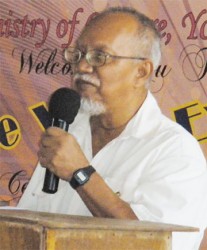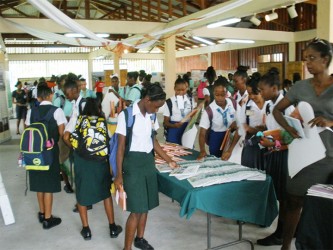By Jeff Trotman

Regional Chairman of Region Ten,Sharma Solomon has called on the National Trust to pay greater attention to the preservation of Fort Nassau on the Berbice River and sites in Linden such as the historical monument at the old saw mill in Silvertown, the Watooka Guest House and the St Aidans Anglican Church on Burnham Drive, which is over a hundred years old.
The Regional Chairman made the call while delivering an address at the launch of Heritage Week 2014, which was held on Tuesday last at the Egbert Benjamin Interpretation Centre, Linden. ‘Celebrating our Diverse Heritage’ is the theme of the Heritage Week activity in Linden, which takes the form of an exhibition, which includes booklets, leaflets and posters on a range of cultural and historical topics.
Lennox Hernandez, Chairman of the Georgetown-based National Trust, in delivering the opening and welcome remarks at the launch of heritage Week 2014, pointed out that Heritage Week is usually held in Georgetown but the National Trust is making a decided effort to reach out to other parts of the country. He said, the National Trust held an exhibition in New Amsterdam in April this year, which has been followed up the Linden outreach.
Highlighting that it is the first time that the National Trust has held an exhibition in Linden, Hernandez stressed that the exercise is an attempt to let the nation know of the important work the Trust is doing to preserve, maintain and inform Guyanese of their national heritage.

Lauren Grant-Williams, Research and Documentation Officer of the National Trust, gave an overview and background of the National Trust. She also pointed to the theme of National Heritage Week 2014, and said a conscious effort has been made to ensure that the exhibition is in keeping with the theme
Highlighting that the heritage of Guyana is diverse and beautiful, the National Trust Research officer pointed out that the exhibition included posters ranging from world heritage goals to various forms of transportation used in Guyana over the centuries as well as brochures and leaflets, which were for free distribution in an effort to evoke nostalgic memories among elders and provide insights to the younger generation and the general public.
“Ultimately, we hope to raise your level of appreciation and encourage you to know, respect, embrace, and promote our many customs,” Grant-Williams said as she further highlighted that the exhibition included snippets of the architecture of various eras of the country’s history as well as aspects of our heritage depicted through postage stamps.
The exhibition also includes agricultural, rural and industrial history, the importance of conservation as well as our Guyanese heritage through coins, creole language, festivals and folklores. Highlighting that the exhibition will be open to the general public until tomorrow between 8 am – 4 pm daily, the National Trust Officer reiterated the hope that the information gathered will be cherished and preserved as well as put into practice.
About seventy people, mainly Linden secondary school students and teachers attended the launching exercise, which featured interludes of steel pan music by Ras Camo as well as a presentation by Orrin Gordon, Chairman of the Linden IMC.
Gordon expressed appreciation for the outreach effort the National Trust is making across the country because in doing so, it is helping people to develop a personal, community and national identity. He said it is important for civics to be part of the school curriculum so that people would be more intimately informed about the socio cultural and historical aspects of the country. He said in his day at school, children were taught about the nine Amerindian tribes and he called on those present to go through the names of the various Amerindian tribes in alphabetical order. He stressed that if people do not know their culture they would adopt the ways of other people.
During his presentation, the Linden IMC Chairman noted that the RH Carr, which played a major role in river transportation between Linden and Georgetown in the early part of the last century but is languishing somewhere in the Essequibo River and he called on the National Trust to look into the possibility of restoring the vessel and placing it in a prominent location so that it could be a meaningful object of national heritage.
Meanwhile, Solomon, who had earlier pointed out that not many people at the launch were aware that the Berbice Slave Rebellion began at Fort Nassau – in Region Ten – “before it migrated to Magdelenburg, which is part of Region Six”, stressed that the exhibition is important in terms of impressing upon viewers the nation’s heritage and helping them to appreciate their national identity. He said from the book, Narrative of Awakening, there is the impressive quotation that before there could be any revolution there must first be a cultural revolution.
Noting that the most of those present at the launch were high school students, Solomon stressed that they stand pivotal in learning the country’s history and then informing the wider community including their parents. He also called on the National Trust to engage in more promotional efforts in making people across the country and Region Ten aware of our national history and heritage.
In response, Chairman of the National Trust said the body, which falls within the Ministry of Culture, Youth and Sport, has an ongoing mission of trying to identify possible national sites across the country. He said the National Trust is currently looking at sites in Region Nine and will be visiting Region Ten sometime in the future.
During the launching exercise, Hernandez pointed out the difference between a monument and a national monument. He highlighted that the term monument under the National Trust Act of 1972 includes any building, structure, object, or other work of man or nature and can be located above or below the surface of the land or the floor of the sea within the territorial confines of the country. However, National Monuments are those which have been expressly declared by the state to be National Monuments.





